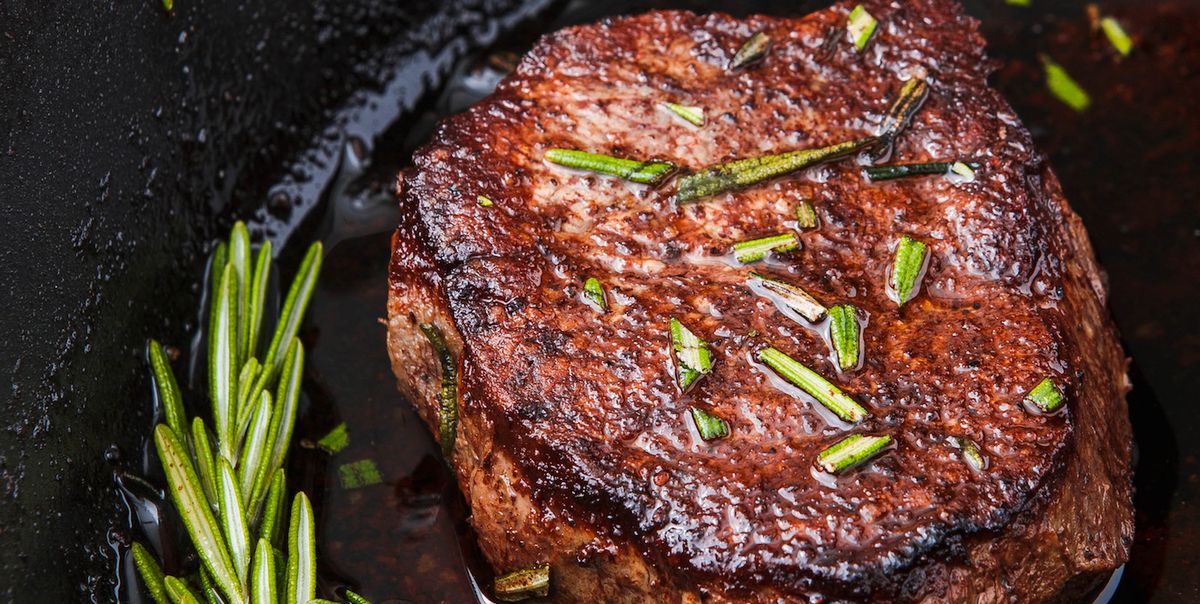
Filet mignon may bring to mind fancy steakhouses or extravagant price points, but we’re here to dispel any fear: it’s actually surprisingly easy to perfect this steak dinner at home. With only a few ingredients and the right technique, you can recreate the steakhouse classic for your Valentines Day dinner or dinner party—no bougie restaurant required. While this dinner may not be difficult to make, because of its steep price tag, you want to make sure you do it right to achieve that desired melt-in-your-mouth-texture. Follow our top tips and tricks to learn just how to perfect this prime steak right at home:
What is filet mignon?
Filet mignon is the smaller tip of tenderloin and one of the most expensive cuts of steak, due to its prized texture. Fun fact: When filet mignon isn’t riding solo on your plate, it can also be a part of another cut—the T-bone. The T-bone consists of strip steak on the bigger side of the bone, and filet mignon on the shorter side. If you can’t decide what you like, opt for a T-bone and you can have both!
How to cook filet mignon:
For a medium steak, we cooked our steak at medium-high heat on the stovetop for around 5 minutes, then flipped, added our butter, and cooked for an additional 3-5 minutes. We then transferred our skillet to a 400° oven and cooked for around 5 minutes. Keep in mind that your steak will continue cooking after you remove it from the oven, so beware of overcooking. Tip: Check the temperature of your meat with a meat thermometer before transferring to the oven. That way, you can see how far you are from your desired temperature.
Temperature guide for filet mignon:
Cook your steak to your desired temp., but we highly recommend not going above 155°:
— Medium-rare: 130-135°
— Medium: 135-145°
— Medium-well: 145-155°
Top tips for cooking filet mignon:
— Do I need to use a cast iron skillet? For the best sear, if you have a cast iron skillet, use it here. If not, just make sure whatever pan you’re using is oven-safe—you’ll be starting on the stovetop and ending in the oven. If you aren’t using a cast iron skillet, opt for heavy bottomed skillets which retain heat and prevent sticking. Nonstick skillets are generally not made for steaks or for ovens.
— How do I get a good sear? One thing is absolutely key: a super-hot pan. Cook the steak in a super-hot preheated skillet—the oil should be almost smoking before you add the meat. Be patient! A deep, crusty sear will take about 3 to 5 minutes per side. Tip: Season the steak with salt and pepper for about 45 minutes to 1 hour, refrigerate, pat dry and then sear. The long preseason draws out a bit of moisture from the steak, which helps achieve a golden crust.
— Do I use oil or butter? BOTH! Start with olive oil (though a neutral oil would work too), then, after flipping the steak, add butter and baste it constantly. Not only does butter make everything taste better, it adds that signature steakhouse flavor—no restaurant would skip it.
— How do I season filet mignon? All you really need for this cut of steak is a bit of salt and pepper. We baste our steak with butter and rosemary to add another layer to this steak, but you can skip the rosemary, or add some garlic if you prefer.
Serving ideas for filet mignon:
We recommend serving this filet with one of our favorite side dishes for steak, including the classic wedge salad, goat cheese-stuffed rolls, Parmesan roasted green beans, and creamy garlic and feta mashed potatoes. That being said, there’s no limit to what you can pair with this steak: melting potatoes, cacio e pepe Brussels sprouts, or air fryer carrots would all work great here.
Looking to take your steak game over the top? Serve a pat of red wine butter, Tuscan butter, or cowboy butter on top of your steak for a flavor game-changer.
Made it? Let us know how it went in the comment section below!